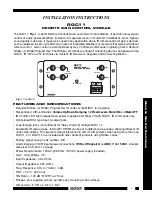
Types N480 and N481
D450044T012
Instruction Manual
MCK-1157
October 1981
www.FISHERregulators.com/lp
R
Types N480 and N481 Hose End Valves
Install, use, and maintain per Fisher
instructions and all applicable federal,
state, laws and codes, and NFPA No. 58 or
Standards K61.1. Periodic inspection and
maintenance is essential.
Introduction
Types N480 and N481 hose end valves are intended
as quick-acting primary shutoff valves for the end of
the transfer hose on bobtail delivery trucks. Standard
valves can be used on propane, butane, and NH
3
service at ambient temperature. For other LP-gases
and compressed gases or other temperature conditions
consult the factory.
Type N480
—Includes a supplementary back check
assembly (Type M570) and is suitable for LP-gas
service only.
Type N481
—Without back check assembly, for use on
NH
3
service only.
Installation
Apply suitable pipe compound to the 1-inch male pipe
threads of a hose coupling (Fisher Type M4100-16 or
equivalent). Screw the hose end valve on the hose
coupling using the wrenching flats on the valve’s inlet
connection. Use sufficient torque to make a tight seal
between the valve inlet and the hose coupling.
The valve’s operating lever rests near the hose
connection when in the closed position. There must be
sufficient clearance between the operating lever and the
hose coupling to insure complete closure of the valve and
easy grasp of the operating lever.
Most hose couplings will work with the N480 or N481,
but if there is insufficient clearance, change the hose
coupling. If possible, store the hose end valve on the
delivery truck in a place protected from the elements.
Operation
When Type N480 or N481 is not connected to a
1 3/4-inch male Acme thread (such as a standard filler
connection), moving the operating lever to the open
position does not open the hose end valve, refer to view 3
in Figure 1. The valve must be attached to a male Acme
fitting, views 1 and 2 in Figure 1, before it will open.
Before attaching either the N480 or N481 to a filler valve,
make sure there is no dirt or other foreign material in
the top of the filler valve or in the hose end valve outlet.
Foreign material could be forced into the filler valve
causing damage and creating a hazardous malfunction.
Also make sure the hose end valve’s operating lever
is in
the closed position, view 1 in Figure 1, before the
valve
is attached to the filler valve. Otherwise the hose end
valve could open as it is threaded on to the filler valve.
As with many quick-acting valves, the
operating lever on the N480 or N481 can
snap closed with some force. Be careful
not to pinch a hand or fingers between the
operating lever and the body when closing
the valve.
As with any hose end valve, loosen
the connection on the filler valve slightly
to allow pressure to bleed off before
completely unscrewing the connection. If
pressure continues to bleed and does not
reduce, never unscrew the hose end valve
because either the filler valve or the hose
end valve has not shut off. Disconnecting
the hose end valve could permit the rapid
escape of gas.
!
WARNING
Figure 1.
N480 Operational Schematic
3
LEVER OPEN,
VALVE NOT
CONNECTED
2
LEVER OPEN,
CONNECTED TO
FILLER VALVE
LEVER CLOSED,
CONNECTED TO
FILLER VALVE
1
CAUTION
!
WARNING
T40384




















